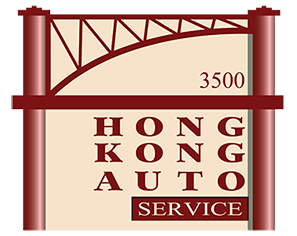The bottom line on alignments
Out-of-whack wheel alignment can lead to all kinds of problems, ranging from safety-compromising premature tire wear to difficulty controlling a vehicle at highway speeds.
Aside from the safety considerations (which should be enough), a misaligned vehicle will slurp excess gas due to the extra friction that misaligned wheels generate.
Considering how vital proper alignment is to a safely and efficiently operating vehicle, it’s imperative that a wheel alignment be performed by expert auto technicians.

At Hong Kong Auto Service, all alignments are performed on state-of-the-art Hunter Engineering Co. wheel-alignment equipment.
At Hong Kong Auto Service, all alignments are performed on state-of-the-art wheel-alignment equipment. This technology ensures an extremely accurate four-wheel alignment.
Prior to setting the alignment, an experienced, ASE-certified technician inspects the vehicle for worn or loose steering and suspension components.
Finally, all vehicles are road-tested to confirm other aspects of the vehicle are performing as designed. This includes confirming tires are balanced so no vibration exists and ensuring they are not causing a drift to one side or the other.
Wheel alignment can be knocked outside of acceptable parameters due to several factors, including damaged tires, wheels, shocks and struts. These parts often become damaged after a vehicle strikes a pothole—hardly a rarity on Chicago-area streets and highways.
The following checklist provides a list of symptoms that might very well indicate a vehicle’s alignment requires correcting. (Please note: these factors also can indicate steering-system or suspension-component damage.)
If your car exhibits any of the following signs, bring it to Hong Kong Auto Service for an inspection:
- Vehicle pulls left or right
- Vibration at any speed, particularly if the steering wheel also vibrates
- Vehicle “rolls” or sways on turns
- Vehicle’s front-end dives when braking
- Vehicle shakes or shimmies at highway speeds
- Vehicle’s rear end squats when accelerating
- Vehicle “wanders” when trying to drive straight or you struggle to keep the vehicle moving straight
- Vehicle bounces or slides sideways on a winding, rough road
- Vehicle “bottoms out” or thumps on bumps
- Vehicle sits lower in the front or rear
- Loss of directional control during sudden stops
